Server Migration Center (SMC) allows you to migrate VMware VMs without agents. This way, the migration does not modify the settings of the operating system of the migration source or occupy the computing resources of the operating system in the migration source. This can effectively eliminate your concerns about server security and performance. This topic describes how to use SMC to migrate VMware VMs without agents.
Prerequisites
The preparations for the migration are complete. For more information, see Before you begin.
Background information
VMware vSphere is a virtualization platform that transforms data centers into aggregated computing infrastructures that include CPU, storage, and network resources. VMware vSphere manages these infrastructures as a unified operating environment and provides you with tools to manage the data centers that are added to the environment. The two core components of VMware vSphere are VMware ESXi and vCenter Server. VMware ESXi is a virtualization platform that is used to create and run VMs and virtual devices. vCenter Server is a service that manages multiple hosts connected on a network and pools host resources.
Open Virtualization Format (OVF) is an open standard that provides an open source, secure, effective, extensible, and portable format for packaging and distributing software for VMs. An OVF package generally consists of .ovf, .mf, .cert, .vmdk, and .iso files.
Benefits of migration without agents
Zero resource consumption
The SMC client does not run inside VMs. Therefore, the migration does not consume the resources of VMs.
High migration efficiency
You do not need to install an agent separately for each VM. This reduces the costs of labor and time.
High security
No operations are performed within the operating system of a VM. This eliminates your concerns about security.
High compatibility
The migration does not depend on the internal environment of the VM operating system. This improves the success rate of migration.
Migration process
 The following section describes the process of migrating VMware VMs without agents:
The following section describes the process of migrating VMware VMs without agents:
Create a Server Migration Connector.
Download an OVF template for creating a Server Migration Connector in the SMC console, import the OVF template to vCenter Server, and then deploy a Server Migration Connector by using the OVF template.
Import the information about the VMware VM to be migrated.
Log on to the Server Migration Connector, configure vCenter Server and the VMware VM to be migrated, and then run commands to import the information about the VMware VM to be migrated.
Create and start a migration job.
In the SMC console, create and start a migration job as prompted. After the migration job is complete, an Elastic Compute Service (ECS) image is generated. You can create an ECS instance by using the image.
Environment requirements
The following table describes the environment requirements that vary based on the Open Virtualization Format (OVF) template.
OVF template | Configurations of a Server Migration Connector | Environment requirements for deploying a Server Migration Connector on vCenter Server | Environment requirements for deploying a Server Migration Connector on VMware ESXi |
SMC VMware Connector 6.5 OVF |
|
|
|
SMC VMware Connector 7.0 OVF |
|
|
|
Required account permissions for vCenter Server and VMware ESXi
If you deploy a Server Migration Connector on vCenter Server, the account used to log on to VMware ESXi and the account used to log on to the VMware VM to be migrated must be granted the following permissions:
Datastore > Browse datastore
Datastore > Low-level file operations
Host > Local operations > Create virtual machine
Virtual machine > Change Configuration > Acquire disk lease
Virtual machine > Change Configuration > Toggle disk change tracking
Virtual machine > Provisioning > Allow virtual machine download
Virtual machine > Provisioning > Allow disk access
Virtual machine > Provisioning > Allow read-only disk access
Virtual machine > Snapshot management > Create snapshot
Virtual machine > Snapshot management > Remove Snapshot
If you deploy a Server Migration Connector on VMware ESXi, you must use an administrator account to log on to VMware ESXi.
Procedure
Step 1: Create a Server Migration Connector
SMC provides OVF templates that are used to create a Server Migration Connector. In this step, download an OVF template, import the OVF template to your vCenter Server or VMware ESXi, and then deploy a Server Migration Connector by using the OVF template.
Download and extract an OVF template
Log on to the SMC console.
In the left-side navigation pane, click Migration Sources.
On the Migration Sources page, click Import Migration source.
On the Import Migration source page, configure the parameters.
The following table describes the parameters.
Parameter
Description
Migration Source Type
The type of the migration source. Select VMware VM from the drop-down list.
Import Method
The method that is used to import the information about the migration source. By default, Use Server Migration Connector to Import VMware VM is selected and cannot be changed.
Description
The description of the procedure for importing the information about a migration source.
In the Description section, download an OVF template based on the version of your VMware ESXi or vCenter Server and decompress the downloaded package.
 Note
NoteIf no OVF template is available for the version of your VMware ESXi or vCenter Server, set the Migration Source Type parameter to Physical Machine/VM/Third-party Cloud Server. Then, use one of the following methods to import the information about the VMware VM to be migrated:
Deploy a Server Migration Connector
Import the extracted OVF template to your VMware ESXi or vCenter Server and deploy a Server Migration Connector by using the OVF template. A Server Migration Connector can be deployed on vCenter Server or VMware ESXi. You can select the deployment environment based on your business requirements.
(Recommended) Deploy a Server Migration Connector on vCenter Server
Import the OVF template of a Server Migration Connector to vCenter Server and deploy the Server Migration Connector by using the OVF template. In this example, vCenter Server 6.7 is used. To deploy a Server Migration Connector on vCenter Server, perform the following steps:
Log on to vCenter Server. Find the vCenter Server host, right-click the name of the host, and then select Deploy OVF Template....
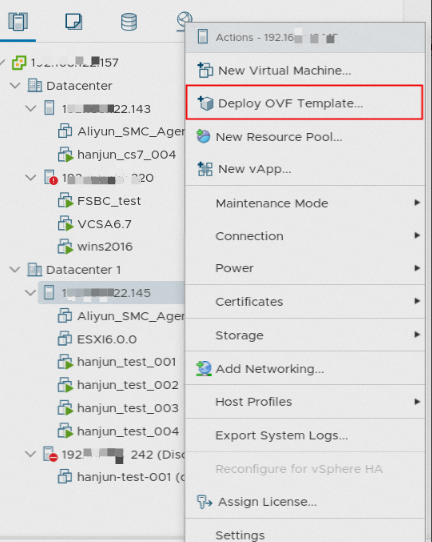
On the Deploy OVF Template page, follow the configuration wizard to create a VM.
Select an OVF template and click NEXT.
Select Local file and click Browse... to select the extracted OVF template.

Specify the VM name and installation location, and click NEXT.
Enter the VM name in the Virtual machine name field and select the installation location.
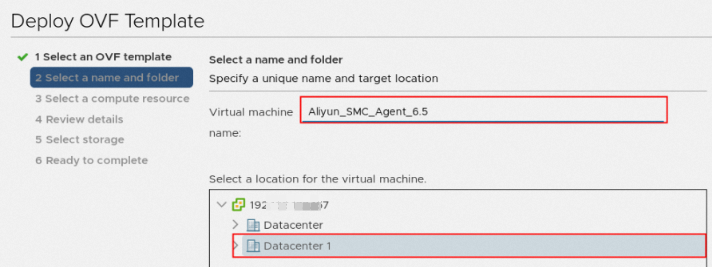
Select a computing resource and click NEXT.
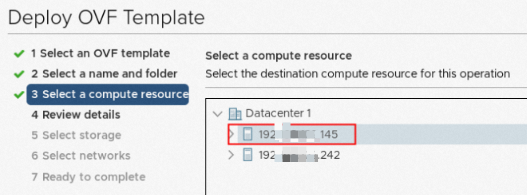
Confirm the template information and click NEXT.

Select the storage and click NEXT.

Select the destination network and click NEXT.
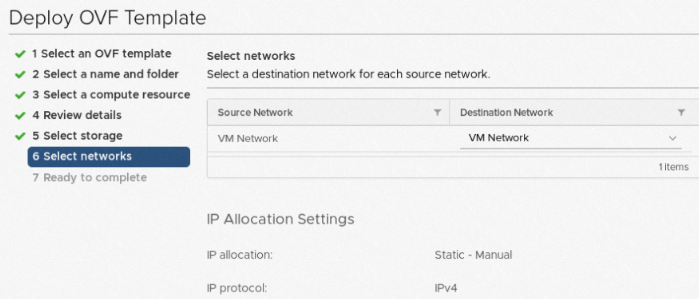
Confirm the configurations and click FINISH.

After the Server Migration Connector is deployed, right-click the Server Migration Connector and choose Power > Power On.
Configure the network environment to ensure that the Server Migration Connector can connect to port 443 of vCenter Server and port 902 of the ESXi host on which the VMware VM to be migrated resides. The preceding port numbers are the default port numbers.
On the Summary tab, obtain the IP addresses of the Server Migration Connector.

Deploy a Server Migration Connector on VMware ESXi
Import the OVF template of a Server Migration Connector to VMware ESXi and deploy the Server Migration Connector by using the OVF template. In this example, VMware ESXi 7.0 is used. To deploy a Server Migration Connector on VMware ESXi, perform the following steps:
Log on to VMware ESXi. In the left-side navigation pane, right-click Virtual Machines and select Create/Register VM.
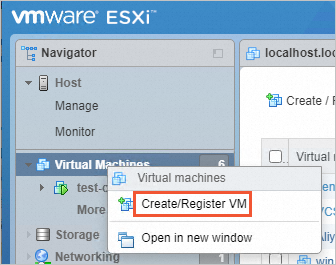
In the Select creation type step, select Deploy a virtual machine from an OVF or OVA file and click Next.
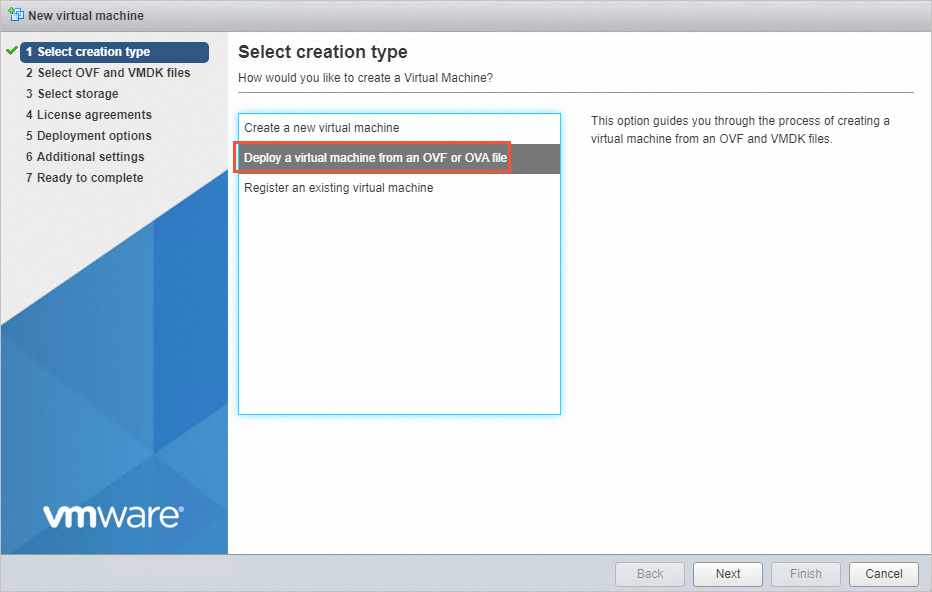
In the Select OVF and VMDK files step, enter a VM name, click Click to select files or drag/drop, select the downloaded OVF template, and then click Next.
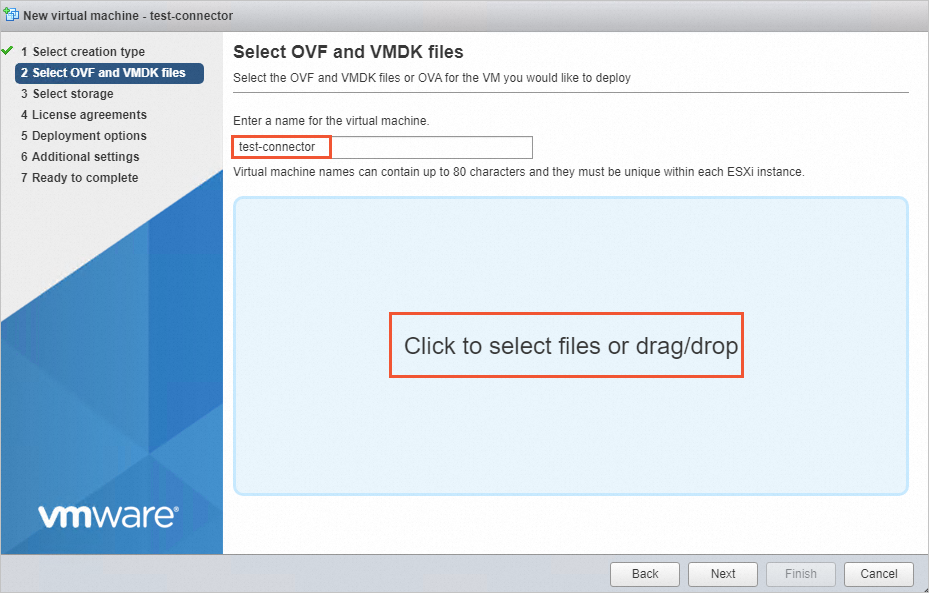
In the Select storage step, click Next.
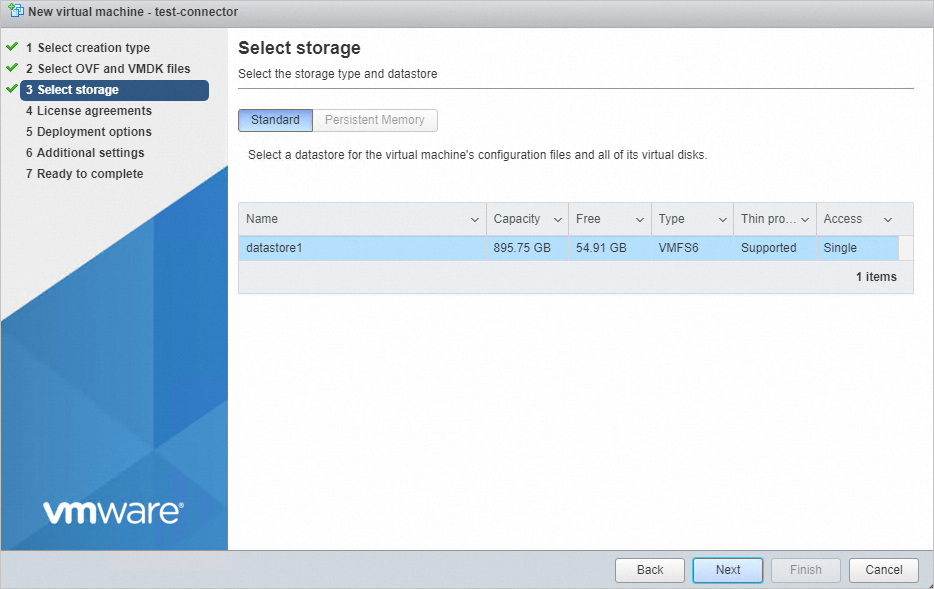
In the Deployment options step, click Next.
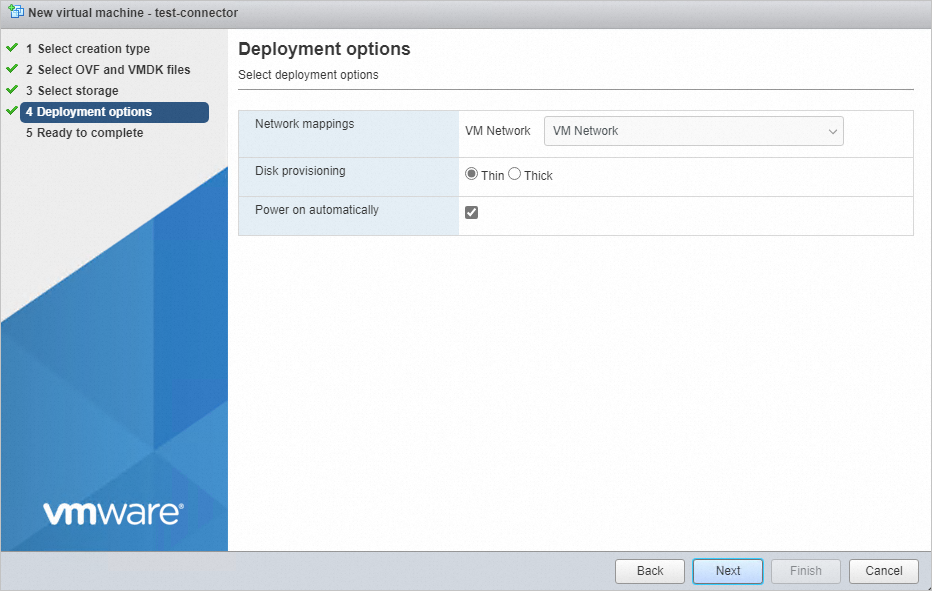
In the Ready to complete step, click Finish.
Wait until the VM is deployed. The IP address of the Server Migration Connector is displayed in the General Information section. By default, Dynamic Host Configuration Protocol (DHCP) is configured in the network settings of the Server Migration Connector. You can modify the network settings based on your business requirements.
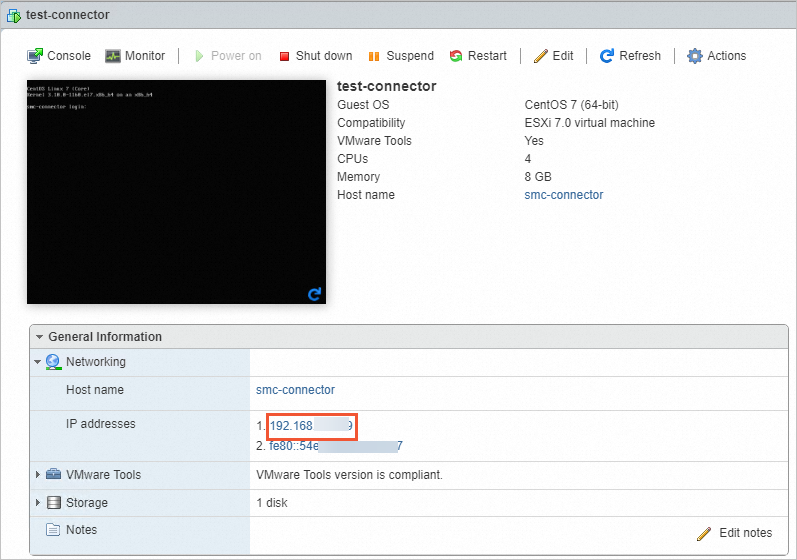
Configure the network environment to ensure that the Server Migration Connector can connect to port 443 and port 902 of VMware ESXi. The preceding port numbers are the default port numbers.
Step 2: Import the information about the VMware VM to be migrated
Log on to the Server Migration Connector, configure the VMware VM to be migrated, and then import the information about the VMware VM to be migrated by running commands.
Configure the VMware VM to be migrated
Log on to the Server Migration Connector.
In this example, SSH remote connection is used. Perform the following steps:
On a terminal from which the Server Migration Connector is accessible over a network, run the following command to connect to the Server Migration Connector. The default username is
root, and the default password is left empty.ssh root@<IP address of the Server Migration Connector>ImportantFor account security, we recommend that you change your password at the earliest opportunity.
Run the following command to check whether the time on the Server Migration Connector is accurate:
dateIf the time is inaccurate, you can run the ntpdate command to calibrate the time. In this topic, the time server at
0.asia.pool.ntp.orgis used.ntpdate 0.asia.pool.ntp.org hwclock --systohcWarningIf the time is inaccurate, the information about the migration source fails to be imported.

Run the following commands to configure the VMware VM to be migrated on your vCenter Server or VMware ESXi:
NoteIn this step, you can obtain all the hosts and VMs in the environment. If you already know the names of the hosts or VMs that you want to configure, skip this step and directly specify the names of the hosts or VMs. For more information, see the How do I migrate the specified VM or a VM on the specified host by performing VMware migration without agents? section of the "FAQ" topic.
cd /root/smc ./configure.shConfigure the IP address, username, password, and port number of vCenter Server or VMware ESXi in sequence. We recommend that you use the default port 443. Sample command output:
[root@localhost ~]# cd /root/smc [root@localhost smc]# ./configure.sh Please input vCenter/ESXi IP:192.168.XX.XX Please input username:administr****@vsphere.local Please input password: Please input port number(default 443):443The "Connect success" message is displayed, and a list of hosts is generated. Enter the ID of the host on which the VMware VM to be migrated resides. You must select a host that is in the Connected state. If an asterisk (*) is displayed in the Connected column of a host, the host is connected.
Test to connect the vCenter/ESXi... Connect success! save to ./vmware_connect_config.json ========Aliyun SMC VMware Configure Tool 1.2======== Connect success! Getting host list progress: [>>>>>>>>>>>>>>>>>>>>>>>>>>>>>>>>>>>>>>>>>>>>>>>>>>100.00%]time: 1.0s Host List: ------------------------------------------------------------------------ ID Name Version Connected 1 192.168.XX.XX 6.7.0 * 2 192.168.XX.XX 7.0.3 * ------------------------------------------------------------------------ Please input the ID of Host(input 0 to exit):1After you enter a host ID, a list of VMs is generated. Enter the ID of the VMware VM to be migrated. You must select a VM that is in the Connected state. If an asterisk (*) is displayed in the Connected column of a VM, the VM is connected.
Test to connect 192.168.XX.XX Connect success! Getting vm list progress: [>>>>>>>>>>>>>>>>>>>>>>>>>>>>>>>>>>>>>>>>>>>>>>>>>>100.00%]time: 2.3s VM List of 192.168.XX.XX: ------------------------------------------------------------------------ ID Name Connected CBT Add 1080 test1 * 1084 win16bios * 1011 centos7-bios-2 * 3008 centos7-uefi * 2001 centos-hw10 * ------------------------------------------------------------------------ Please input the ID of VM to be migrated (input 0 to exit):1084Select the architecture of the VMware VM to be migrated.
-------------------------------------------------------------- 0 x86_64 1 i386 2 arm64 -------------------------------------------------------------- Please choose the architecture:0Check whether the operating system recognized by the system is the actual operating system of the current VM. If the recognized operating system is incorrect, enter n, and then enter the number that corresponds to the actual operating system in the list. For example, you can enter 10 to select the Windows Server 2016 operating system.
NoteThe preset operating system when a VM is created on vCenter Server may be incorrect. You must confirm the operating system of the VM.
Is [CentOS 7 (64-bit)]' truly the OS of VM (y or n)?n ------------------------------------------------------------------------ 0 CentOS 1 Ubuntu 2 SUSE 3 OpenSUSE 4 Debian 5 RedHat 6 Others Linux 7 Windows Server 2003 8 Windows Server 2008 9 Windows Server 2012 10 Windows Server 2016 11 Windows Server 2019 12 Windows Server 2022 ------------------------------------------------------------------------ Please choose the OS of VM:Select the system disk. By default, the virtual disk with the number
0is selected.-------------------------------------------------------------- 0 [datastore1] win16bios/wins16bios-000001.vmdk 1 [datastore1] wins16bios/wins16bios_1-000001.vmdk -------------------------------------------------------------- Please choose the system disk (default 0):0If an asterisk (
*) is displayed in theAddcolumn that corresponds to the VM name, the VM is added to the migration list.VM List of 192.168.XX.XX: -------------------------------------------------------------- ID Name Connected CBT Add 481 TEST_CLONE_1 * 389 win16bios * * 338 hanjun_test_001 * 386 Aliyun_SMC_Agent_6.5 * 393 win16uefi -------------------------------------------------------------- Please input the ID of VM to be migrated (input 0 to exit):0If you want to migrate multiple VMs, enter the IDs of the VMs to be migrated.
If you want to migrate only one VM, enter 0 and return to the host list. If you want to migrate VMs on other hosts, repeat the preceding steps. Otherwise, enter 0 to exit the configuration.
Optional. Run the following command to view the generated vmware_connect_config.json and vmware_migrate_config.json files:
llA command output similar to the following one is returned:
[root@localhost smc]# ll total 5588 drwxrwxrwx. 4 root root 239 Oct 17 17:27 Check -rwxrwxrwx. 1 root root 6884 Oct 14 15:54 client_data -rwxrwxrwx. 1 root root 151 Oct 14 17:47 configure.sh drwxrwxrwx. 2 root root 72 Nov 1 01:15 dist -rwxrwxrwx. 1 root root 38878 Oct 14 15:54 EULA drwxrwxrwx. 2 root root 4096 Oct 17 17:27 Excludes -rwxrwxrwx. 1 root root 5633792 Oct 31 19:43 go2aliyun_client -rwxrwxrwx. 1 root root 146 Oct 14 15:54 user_config.json -rw-r--r--. 1 root root 263 Nov 10 18:05 vmware_connect_config.json -rw-r--r--. 1 root root 18406 Nov 10 18:07 vmware_migrate_config.json
Import the information about the VMware VM to be migrated
After you log on to the Server Migration Connector, start the SMC client and import the information about the VMware VM to be migrated to the SMC console by running commands.
When the SMC client is running, do not perform operations on the VMware VM to be migrated, such as shutting down the VMware VM, restarting the VMware VM, and creating or deleting snapshots for the VMware VM. If you create or delete snapshots for the VMware VM to be migrated, the migration may fail. If the migration fails, run the ./dist/migrate_configure command in the /root/smc home directory of the SMC client to obtain the VM configurations again. Then, run the ./go2aliyun_client --jobtype=3 command to start a new SMC client.
Obtain the SMC access token or AccessKey pair.
Obtain the SMC access token: recommended. An SMC access token consists of an access token ID and an access token code. If you do not have an SMC access token, go to the Import Migration source page in the SMC console. In the Description section, click Generate and copy the generated access token ID and access token code.

Obtain the AccessKey pair: An AccessKey pair of an Alibaba Cloud account consists of an AccessKey ID and an AccessKey secret. If you have not created an AccessKey pair, create one first. For more information, see Obtain an AccessKey pair.
Log on to the Server Migration Connector and run the following commands to import the information about the VMware VM:
chmod +x ./go2aliyun_client ./go2aliyun_client --jobtype=3Enter the SMC access token or AccessKey pair as prompted. In this example, the SMC access token is used. The returned information is similar to the following content. If the
Import Source Server [s-bp14zd35128xgjdbh****] Successfullymessage is displayed, the information about the VMware VM to be migrated is imported.[root@localhost smc]# ./go2aliyun_client --jobtype=3 [2022-11-10 10:12:17] [Info] ========= Goto Aliyun VMware Client1.2.2 ========= [2022-11-10 10:12:17] [Info] Load User Config... Please Enter Access Token Id Or Access Id: at-bp1bq6h8194dnpod**** Please Enter Access Token Code: ****************************** [2022-11-10 10:12:17] [Info] Load Client Data... [2022-11-10 10:12:17] [Info] Load VMware Connect Config... [2022-11-10 10:12:17] [Info] Load VMware Migrate Config... OS Info: Microsoft Windows Server 2016 (64-bit) CPU Info: Intel(R) Xeon(R) Platinum 8269CY CPU @ 2.50GHz CPU: 4 Cores Memory: 8.00GB Hostname: WIN-5KSIG3H94RM IP Address: Mac Address: 00:50:56:b6:**:** [2022-11-10 10:12:17] [Info] Verify User Account... [2022-11-10 10:12:17] [Info] Generate SSH Key... [2022-11-10 10:12:18] [Info] Import Source Server... [2022-11-10 10:12:18] [Info] Import Source Server [s-bp131kz499d1e22f****] Successfully! [2022-11-10 10:12:18] [Info] ========= Run In BackGround Daemon Mode ========= [2022-11-10 10:12:18] [Info] Goto Aliyun Begin... [2022-11-10 10:12:18] [Info] Check Source Server Status... [2022-11-10 10:12:18] [Info] Check Replication Job Status... Please Goto SMC Console To Create New Job, time: 4m30s \
Step 3: Create and start a migration job
In the SMC console, create and start a migration job as prompted. Valid values of the Destination Type parameter when you create the migration job:
(Recommended) ECS Image: You can migrate the VMware VM to an ECS image and then create an ECS instance by using the image.
ECS Instance: You can migrate the VMware VM to an ECS instance that you have purchased. The storage system and operating system of the VMware VM must be compatible with those of the destination ECS instance.
WarningAfter a migration job is created, all original data is deleted from the destination ECS instance. However, the system does not delete data from the VMware VM. If the destination ECS instance contains important data, we recommend that you do not directly migrate the VMware VM to the destination instance.
Log on to the SMC console.
In the left-side navigation pane, click Migration Sources.
On the Migration Sources page, click the VMware VM tab, find the migration source that you want to use, and then click Create Migration Job in the Actions column.
ImportantBefore you create a migration job, make sure that the migration source is in the Active state.

In the Create Migration Job dialog box, configure the parameters.
The following table describes the parameters.
Parameter
Description
Migration Job Type
The type of the migration job. By default, VMware Agentless Migration is selected.
Migration Job Name
The name of the migration job.
NoteThe job name must be unique within an Alibaba Cloud region.
Job Description
The description of the migration job.
Destination Region
The Alibaba Cloud region to which you want to migrate the VMware VM. This parameter is required. For more information about regions, see Regions and Zones.
Destination Type
(Recommended) ECS Image: You can migrate the VMware VM to an ECS image and then create an ECS instance by using the image.
ECS Instance: You can migrate the VMware VM to an ECS instance that you have purchased. The storage system and operating system of the VMware VM must be compatible with those of the destination ECS instance.
WarningAfter a migration job is created, all original data is deleted from the destination ECS instance. However, the system does not delete data from the VMware VM. If the destination ECS instance contains important data, we recommend that you do not directly migrate the VMware VM to the destination instance.
During the migration, a pay-as-you-go cloud disk is created for temporary use. The cloud disk serves as a data transfer hub and is automatically released after the migration is complete.
During the migration, the operating system of the destination ECS instance is changed, and the automatic snapshots of the system disk are deleted and cannot be recovered. You can manually disable the Delete Automatic Snapshots While Releasing Disk feature to retain the snapshots. For more information, see Delete automatic snapshots while releasing a disk.
The number of data disks attached to the ECS instance is greater than or equal to that of data disks attached to the source server. Otherwise, the disk data of the source server cannot be migrated to the destination ECS instance. In this case, you must attach more data disks to the ECS instance. For more information, see Attach a data disk.
The capacity of the system disks and data disks attached to the ECS instance is larger than or equal to that of the system disks and data disks attached to the source server. If you want to shrink the system disks and data disks attached to the source server, make sure that the capacity of the system disks and data disks attached to the destination ECS instance is larger than or equal to the size of the data on the system disks and data disks attached to the source server. Otherwise, the data of the source server cannot be fully migrated to the destination ECS instance. In this case, you must extend the data disks and system disks attached to the ECS instance. For more information about how to resize a cloud disk, see Overview.
Image Name
The name of the ECS image that is generated by SMC for the VMware VM to be migrated.
NoteThe image name must be unique within an Alibaba Cloud region.
Destination Disk Size (GiB)
The disk configurations of the destination server. Configure the following parameters based on your business requirements:
System Disk: the system disk size of the VMware VM. Unit: GiB.
Data Disk<N>: the data disk size of the destination ECS instance. Unit: GiB. Valid values: 20 to 32768.
If you select Data Disk<N>, a destination data disk is generated.
Nindicates the serial number of the data disk.The size of the destination data disk must be greater than or equal to that of the source data disk.
NoteData Disk<N> is displayed only if the migration source has a data disk. For more information, see the Why are the data disk parameters of a migration source not displayed in the Create Migration Job dialog box? What do I do? section of the "FAQ" topic.
Expert Mode
Network Type
The type of the network that is used to migrate data to the intermediate instance. During migration, SMC creates an intermediate instance that connects to a vSwitch in a virtual private cloud (VPC). If you select Public Network, a public IP address is assigned to the intermediate instance.
Public Network
SMC migrates data to the intermediate instance over the Internet. If you select Public Network, make sure that the source server can access the Internet. You can determine whether to specify a VPC and a vSwitch based on your business requirements.
If you specify a VPC and a vSwitch, SMC creates an intermediate instance that connects to the specified VPC and vSwitch.
If you migrate multiple migration sources at a time, you can specify the same VPC and vSwitch for migration jobs. This improves the usage of VPC resources. In this case, you can migrate a maximum of 100 migration sources at a time.
If you do not specify a VPC or a vSwitch, SMC automatically creates a VPC and a vSwitch, and creates an intermediate instance that connects to the created VPC and the vSwitch.
If you do not specify a VPC or a vSwitch before you migrate multiple migration sources at a time, SMC creates a VPC for each intermediate instance.
NoteEach Alibaba Cloud account can have up to 10 VPCs in a region, including the VPCs that are manually created and the VPCs that are automatically created by SMC. Therefore, you can migrate up to 10 migration sources at a time if you do not specify a VPC or a vSwitch. For more information about how to increase the VPC quota, see Manage VPC quotas.
VPC
SMC migrates data to the intermediate instance over a VPC. If you select VPC, you must specify a VPC and a vSwitch and make sure that the source server can connect to the VPC.
NoteIf your server in a data center, your VM, or your third-party cloud server can connect to a VPC, we recommend that you select this network type to migrate data. Compared with migration over the Internet, migration over a VPC is more efficient and stable. You can use VPN Gateway, Express Connect, and Smart Access Gateway to connect a migration source to a VPC. For more information, see Connect a data center to a VPC.
Transmission Speed Limit
The maximum bandwidth for data transmission during migration. Unit: Mbit/s.
Compression Ratio
The compression ratio of the data to be migrated. Set the compression ratio based on your business requirements.
If the bandwidth is limited, a high compression ratio improves the transmission efficiency.
If a high bandwidth is available, we recommend that you do not compress data. Data compression consumes CPU resources of the migration source.
Valid values: 0 to 10. Default value: 7. A value of 0 indicates that data is not compressed.
Checksum Verification
Specifies whether to verify data integrity by using a checksum. By default, this feature is disabled. If you enable this feature, data integrity is ensured, but transmission speed may be reduced.
License Type
The license type. Valid values:
Alibaba Cloud: the Microsoft license provided by Alibaba Cloud. For more information, see the What Windows Server licenses does Alibaba Cloud support? section of the "FAQ" topic.
BYOL: SMC allows you to bring your own license (BYOL). You can bring your own Microsoft license or register with Red Hat Cloud Access. For more information, see the Is BYOL supported when I migrate servers by using SMC? section of the "FAQ" topic.
Image Check
Specifies whether to enable the image check feature. The image check feature checks whether an image is valid and whether the image can be used to create full-featured ECS instances. You can use the image check feature when you create a server migration job or an agentless migration job for a VMware VM.
This feature helps you identify potential issues in images or ECS instances after the migration job is complete, and provides solutions to the identified issues. This helps you improve the success rate of starting ECS instances.
For more information, see Configure image check.
Automatic Incremental Synchronization
Specifies whether SMC automatically synchronizes incremental data of the migration source to Alibaba Cloud.
NoteIf you set the Destination Type parameter to ECS Instance, incremental data synchronization is not supported.
To enable this feature, you must configure the following parameters:
Synchronization Interval: the interval at which SMC automatically synchronizes incremental data to Alibaba Cloud.
Maximum Reserved Images: the maximum number of images that can be retained during incremental migration.
SMC automatically synchronizes incremental data to Alibaba Cloud at the specified interval. You must enable the Changed Block Tracking (CBT) feature for incremental migration. For more information about the best practices for incremental migration, see Migrate incremental data from a VMware VM without an agent.
If you disable this feature, incremental data is not synchronized.
Execution Method
The method that is used to run the migration job. Valid values:
Migrate Now: The migration job starts to run immediately after it is created.
Migrate Later: The migration job automatically starts at the specified time after it is created.
ImportantThe earliest time that you can specify to run a migration job is 10 minutes after the job is created.
Create Only: After the migration job is created, you must manually start the job.
Default value: Migrate Now.
Migration Job Tags
The tags that you specify for the migration job. Each tag contains a key and a value. You can use tags to query and manage migration jobs. For more information, see Use tags to manage migration sources and migration tasks.
NoteYou can specify up to 20 tags for a migration job.
Intermediate Instance Type
The type of the intermediate instance. Select an intermediate instance type based on your business requirements.
If you specify an instance type, SMC creates an intermediate instance of the specified instance type. If the specified instance type is unavailable, you cannot create the migration job.
If you do not specify an instance type, SMC automatically selects an instance type to create an intermediate instance.
Click Create.
On the Migration Jobs page, click the VMware Agentless Migration tab. Wait until the migration job is complete.

If the migration job turns to the Completed state, the migration job is successful.
If you set the Destination Type parameter to ECS Image, click Create Instance in the Actions column of the migration job to create an ECS instance by using the custom image that is generated. For more information, see Create an instance on the Custom Launch tab.
If you set the Destination Type parameter to ECS Instance, click View Destination Instance in the Actions column of the migration job to view the details of the destination instance.
If the migration job turns to the InError state, the migration job fails. You can check the logs to troubleshoot the failure. Then, restart the migration job. For more information about common errors and solutions, see FAQ and Errors occurred during a server migration.
Optional. Migrate another VMware VM.
If you specify multiple VM IDs when you configure the VMware VM to be migrated, you can close the SMC client process after the current VMware VM is migrated, and then migrate another VMware VM. To migrate another VMware VM, perform the following steps:
Log on to the Server Migration Connector. For more information, see the Configure the VMware VM to be migrated section in Step 2 of this topic.
Press
Ctrl+Cto exit the current SMC client process that is running. Then, run the following command to close the SMC client process:./dist/finish 1Run the following command to start a new SMC client. Then, migrate another VMware VM.
./go2aliyun_client --jobtype=3
Step 4: (Optional) Configure multiple jobs to migrate VMs
If you want to migrate a large number of VMware VMs, you can configure multiple jobs to migrate VMs at a time to improve migration efficiency.
You can close the SMC client process for a VMware VM and migrate another VMware VM only after the first VMware VM is migrated. If you close the SMC client process for a VMware VM whose migration is in progress, the VMware VM fails to be migrated.
Optional. Create multiple Server Migration Connectors.
You can run up to five SMC clients on each Server Migration Connector. If you require more than five SMC clients, you can deploy multiple Server Migration Connectors by cloning a Server Migration Connector or using the OVF template based on the remaining available resources in the current VMware environment. Then, run the SMC clients on different Server Migration Connectors. In this example, a Server Migration Connector is cloned.
Right-click the Server Migration Connector to be cloned and choose .

Specify the VM name, installation location, computing resources, storage space, and clone options in sequence.
For more information, see the Step 1: Create a Server Migration Connector section of this topic.
Log on to the Server Migration Connector. For more information, see the Configure the VMware VM to be migrated section in Step 2 of this topic.
Run the following commands to obtain multiple SMC clients for each Server Migration Connector.
You can run up to five SMC clients on each Server Migration Connector at a time. You can copy multiple SMC client files based on your business requirements.
cd /root cp -r smc smc2 cp -r smc smc3 cp -r smc smc4 cp -r smc smc5 mv smc smc1ImportantYou can run up to five SMC clients on each Server Migration Connector at a time.
Run the following commands to run the configuration script for each Server Migration Connector.
If you run multiple SMC clients on a Server Migration Connector, you can go to the directory of the specified SMC client and run the
./configure.shcommand to run the configuration script for the specified SMC client. In this example, the second SMC client is used.cd /root/smc2 ./configure.shFor more information about how to run the configuration script, see the Configure the VMware VM to be migrated section in Step 2 of this topic.
Run the following command to view the processes of the SMC clients that are running:
ps -ef | grep smcvmware_clientThe following figure shows a similar command output.
 Note
NoteWhen multiple SMC clients are running, the SMC client processes are named based on the time sequence in which they start, such as smcvmware_client_1, smcvmware_client_2, ..., and smcvmware_client_N.
After the migration job that corresponds to each SMC client is complete, exit the SMC client process by pressing
Ctrl+C. Then, run the following command to close the current SMC client process:./dist/finish NIn the command, N indicates the process sequence and must be replaced with the actual value, such as 1 or 2.
Run the following command to start a new SMC client. Then, migrate another VMware VM.
./go2aliyun_client --jobtype=3